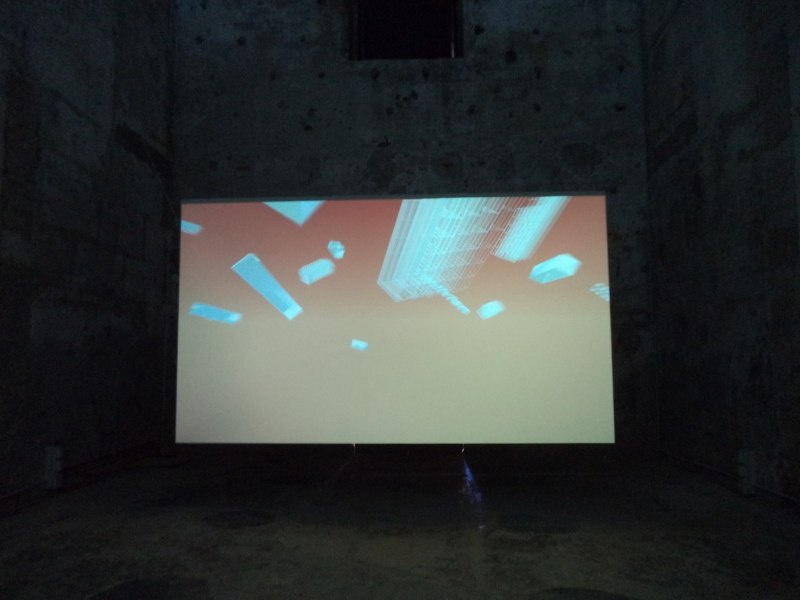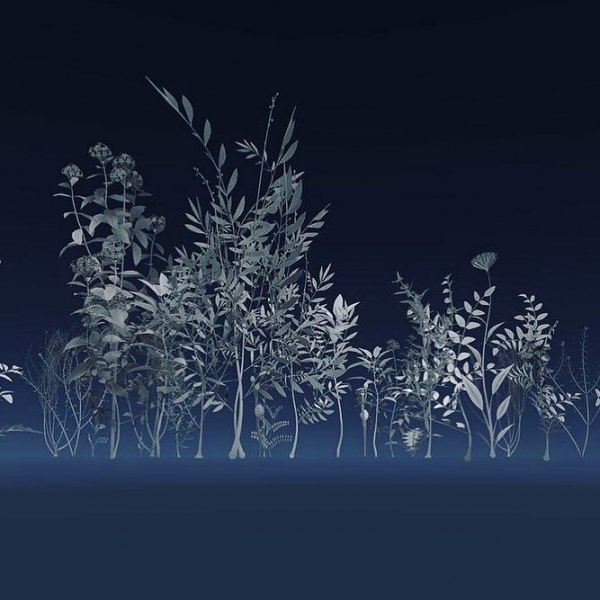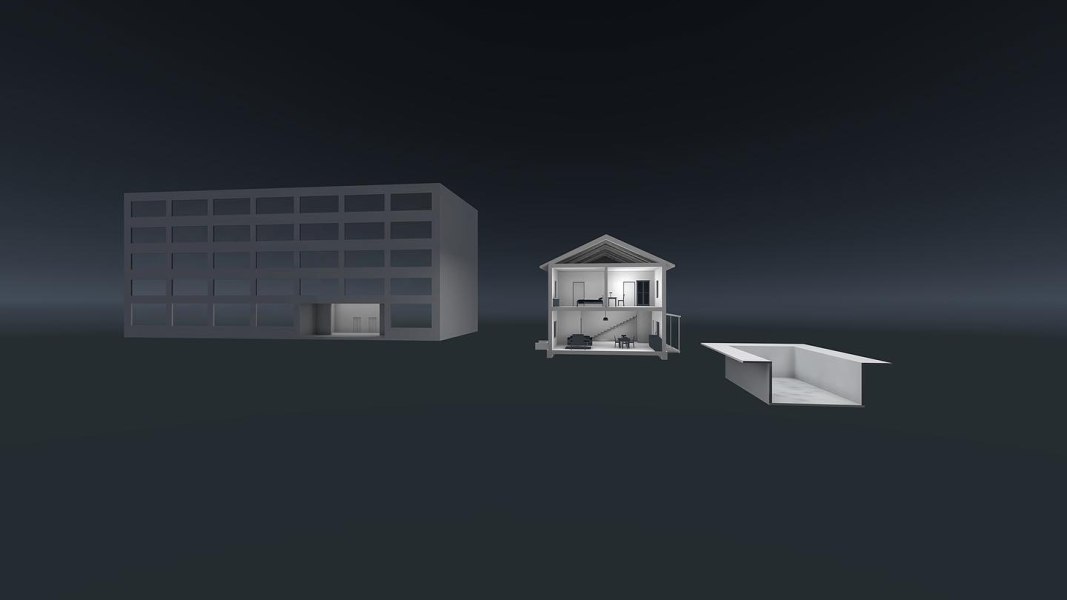Per la Biennale di Venezia, presso lo Spazio “Punch”, è ospitata la mostra dal titolo I pity the garden, avente una videoinstallazione di Mariam Natroshvili e Detu Jincharadze. Precisamente, loro rappresentano il Padiglione Nazionale della Georgia. Nella poesia I pity the garden, Forugh Farrokhzad criticava la società, nella propria rinuncia a curare la libertà personale, in specie se delle donne. Mariam Natroshvili e Detu Jincharadze sono nati in Georgia, qualche anno prima che si disintegrasse l’URSS. I cambiamenti politici avvengono dopo una lunga serie di avvisaglie. Gli spettatori della mostra sono invitati a vivere un’esperienza di realtà virtuale. Dialetticamente, le immagini “giocano” fra l’urbanizzazione cittadina ed il bosco selvatico. Nel complesso, si percepisce una distopia. L’artificio della realtà virtuale favorisce la “crescita” partecipativa. Così si passa dalle limitazioni esteriori ai coinvolgimenti trascendentali. La realtà materiale nasconderebbe certe “avvisaglie”, avendo un senso che può attrarci o respingerci, se in riferimento al nostro vissuto. Qualcosa che crescerà tramite la stimolazione percettiva. Potremmo sostenere che la realtà virtuale svela le “avvisaglie” dell’entropia sotto l’inerzia. Ma la società contemporanea conosce il paradosso dell’urbanizzazione selvaggia. Questa è una distopia, per l’ecologismo. Gli artisti disegnano una città dall’architettura razionalistica, ma senza il pullulare degli animi. Dunque il trascendentale della coscienza rifletterebbe uno spettro della percezione. E’ interessante la metafora della porta. Ne avremmo direttamente una d’incarnata, attraverso la realtà virtuale. Di norma, la curiosità verso l’aldilà è crescente. In una trasfigurazione, s’avverte che il pensiero partecipi della pelle. L’inerzia astratta del primo rifletterà l’entropia materiale della seconda. Nell’artificio della realtà virtuale, sarebbe possibile il sogno d’una trasfigurazione. Il disordine dei pensieri addirittura “cresce”: dall’inconscio libidinoso alla carne… vera e propria. Però sarà una distopia, rispetto alla naturalità del vissuto.
Immanuel Kant avallò uno schematismo trascendentale, per l’immaginazione che facesse “l’intermediaria” tra la percezione sensibile e la riflessione concettuale. Tutto questo si doterebbe d’una “porta” carnale, grazie alla realtà virtuale. Mariam Natroshvili e Detu Jincharadze si chiedono che cosa può “schematizzare” l’immagine dell’inorganicità paradossalmente animata. La risposta ci sembra dialettica. La natura ha il governo dell’entropia; l’artificialità ha il (mal)governo della distopia. A causa dell’urbanizzazione, il giardino si secca inutilmente. Ai visitatori della mostra sono offerti gli occhiali, affinché si preveda il futuro distopico dell’Antropocene che, addirittura, stravolga la realtà virtuale. La cinematografia ha già raccontato qualcosa, ad esempio con la saga che si chiama Matrix. Gli artisti ci fanno percorrere una strada cittadina. Però la linea d’orizzonte sprofonderà, e nella “matrice” d’un trascendentale percettivo. Possiamo simboleggiare il concettualismo attraverso un cassetto, il quale sistemi la realtà (materiale od astratta). Di conseguenza il suo telaio si darebbe all’orizzonte, ed “aggrappandosi” dal vuoto. E’ un trascendentale distopico per la realtà virtuale, se la matrice rimpiazza direttamente il cassetto, facendosi pre-impostare da qualcun altro. Percepiremo un “salto” sul nulla, dove non “atterreremo” mai con la coscienza. Nella videoinstallazione di Mariam Natroshvili e Detu Jincharadze, la matrice forse apparterrà alle foglie (partendo dal livello naturale) od ai mattoni (partendo dal livello artificiale). Trattasi di elementi che “viaggiano” sospesi nel vuoto. In un caso la natura protesterà contro la cementificazione; nell’altro caso l’artificialità avrà “stroncato” la vitalità. La sedentarietà del videogioco riuscirà a tonificare non solo la mente, ma addirittura la carne (mentre nessuno frequenterà ancora l’attrezzatura da palestra). Contro di quella, il disegno del ghosts garden avrà riunito una serie di piante, già estintesi (nella vita reale!) a causa dell’antropocentrismo. Le gemme crescerebbero “inzaccherate” dai mattoni, all’inquinamento della distopia.
Francesco Martin liricamente si chiede se chi “viaggia con la mente” nasca tra foreste evolute e ghiacci in eterno, da popoli “variopinti” per stirpe, ma soprattutto lontano dal Big Bang. Questo avrebbe fatto cadere i “sassi desertici” per “l’accampamento” dei potenti in guerra, stringenti nei pugni effimeri granelli di sabbia. All’artificio della realtà virtuale, ci si allontanerebbe dal Big Bang. La videoinstallazione di Mariam Natroshvili e Detu Jincharadze appare astrattamente glaciale per spettralità, fra foreste in grado di rinascere solo cementando le proprie gemme. Indossando gli occhiali, il visitatore della mostra s’accampa con l’intero corpo. Non è chiaro quanto potere gli si dia, sotto la programmazione altrui (degli artisti). La sceneggiatura della videoinstallazione invita ad accamparsi, con le porte che s’aprono ad un passaggio segreto, affinché noi abitiamo in un arco di tempo, fra le cause e gli effetti del suo “terreno”. La percezione del deserto deriverà da una programmazione distopica della digitalizzazione. La foglia vegetale crescerà soltanto nel “rottame” d’una lampada, per l’urbanizzazione selvaggia, e dopo che la realtà virtuale sarà stata capace di far esplodere la luce naturale. Percepiamo così lo schermo allestito per la mostra. Esso avrà le immagini sospese nell’inerzia d’un “ripescaggio” (dall’esperienza virtuale).
THE IMMERSIVE TRANSCENDENTALITY IS THE MATRIX THAT REPLACES THE DRAWER
For the Venice Biennale, at the Spazio “Punch”, is hosted the exhibition called I pity the garden, which has a video-installation of Mariam Natroshvili and Detu Jincharadze. Precisely, they represent the National Pavilion of Georgia. In the poem I pity the game, Forugh Farrokhzad criticized the society, in the own waiver of a care for the personal freedom, especially about the women. Mariam Natroshvili and Detu Jincharadze were born in Georgia, some years before the collapse of URSS. The political changes happen after a long series of the first signs. The spectators of the exhibition are invited to live an experience of virtual reality. Dialectically, the images “play” between the city urbanization and the wild wood. Overall, we perceive a dystopia. The artifice of the virtual reality favours a participative “growth”. So we pass from the exterior limitations to the transcendental involvements. The material reality would hide some “first signs”, having a sense that can attract or reject us, if they are in reference to our living. Something that will grow through the perceptual stimulation. We could argue that the virtual reality unveils the “first signs” of the entropy under the inertia. However the contemporary society knows the paradox of the urban sprawl. This is a dystopia, according to the ecologist. The artists draw a city with a rationalist architecture, but without the brimming souls. So the transcendentality of the consciousness would reflect a spectre of the perception. The metaphor of the door is interesting. That one would be also within us, incarnated through the virtual reality. Normally, the curiosity for the afterworld is growing. In a transfiguration, we feel that the thought takes part in the skin. The abstract inertia of the first element will reflect the material entropy of the second element. In the artifice of the virtual reality, the dream of a transfiguration should be possible. The mess of the thoughts even “grows”: from the libidinous unconscious to the out-and-out… flesh. However that will be a dystopia, compared to the naturalness of the living.
Immanuel Kant corroborated a transcendental schematism, for the imagination which acted “as an intermediary” between the sensible perception and the conceptual reflection. All that would be provided with a “carnal” door, through the virtual reality. Mariam Natroshvili and Detu Jincharadze ask themselves what can “schematize” the image of an inorganic nature paradoxically in animation. The answer seems dialectical to us. The nature has its government from the entropy; the artificiality has its (mis)government from the dystopia. Because of the urbanization, the garden dries out uselessly. The glasses are given to the visitors of the exhibition, so that they foresee the dystopian future of the Anthropocene which, even, upsets the virtual reality. The cinematography already narrated something, for example by the saga called Matrix. The artists allow us to travel along a city road. However the horizon line will sink, in the “matrix” of a perceptual trascendentality. We can symbolize the conceptualism through a drawer, which sets the reality (material or abstract). Consequently its framework would happen at the horizon, and “hanging on to” the vacuum. This is a dystopian trascendentality for the virtual reality, if the matrix replaces directly the drawer, as regards its pre-setting from somebody else. We will perceive a “jump” into the nothingness, where we will never “land” with the consciousness. In the video-installation of Mariam Natroshvili and Detu Jincharadze, the matrix maybe will belong to the leaves (starting from the natural level) or to the bricks (starting from the artificial level). Those are elements that “travel” into the void. In one case the nature will protest against the cementification; in the other case the artificiality will “tear to shreds” the vitality. The sedentariness of a video-game will be able to tone up not only the mind, but even the flesh (while nobody will yet attend the gym equipment). Against that one, the drawing of a ghosts garden would have gathered a series of plants, already extinct (in the real life!), because of the anthropocentrism. The buds would grow “bedraggled” by the bricks, at the pollution of the dystopia.
Francesco Martin lyrically asks himself if somebody who has “a journey into the mind” is born between the evolved forests and the eternal ices, from the population “varicoloured” by the ancestry, but principally far away from the Big Bang. This one would have allowed the “desert stones” to fall, for “the encampment” of the powerful people at war, squeezing in the ephemeral fists the grains of sand. At the artifice of the virtual reality, we would move away from the Big Bang. The video-installation of Mariam Natroshvili and Detu Jincharadze appears abstractly glacial for a spectrality, between the forests able to be reborn only cementing the own buds. Wearing the glasses, the visitor of the exhibition camps with the entire body. It is not clear how much power he can obtain, under the programming of somebody else (of the artists). The screenplay of the video-installation invites us to camp, with the doors that are opened for a secret passage, in order that we dwell in a span of time, between the cause and effect of its “terrain”. The perception of a desert will derive from a dystopian programming of the digitalization. The vegetable leaf will grow only in the “scrap” of lamp, for the urban sprawl, and after the virtual reality will be able to detonate the natural light. So we perceive the screen set up for the exhibition. It will have the images hanging in the inertia of a “repechage” (from the virtual experience).






